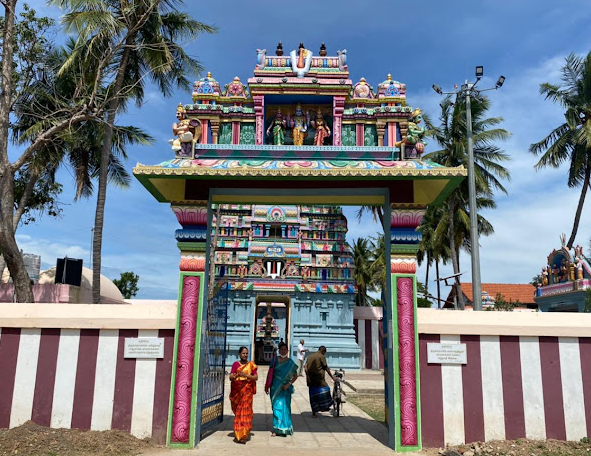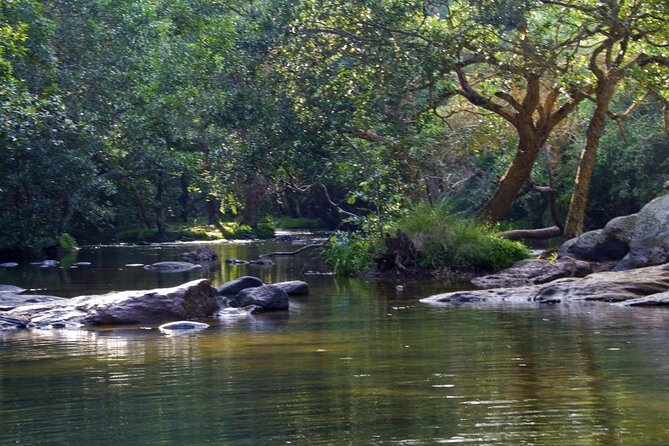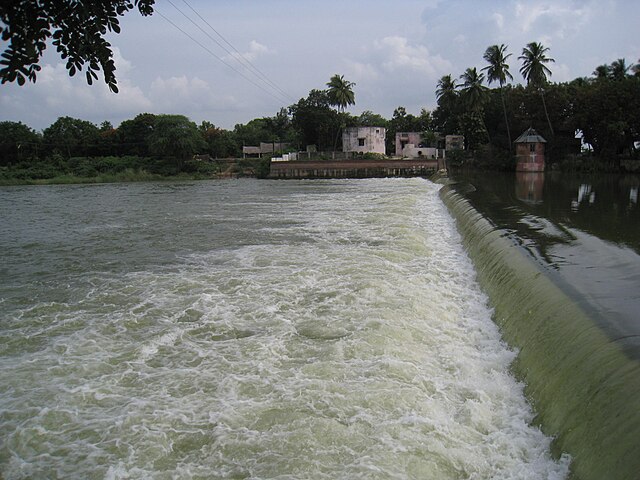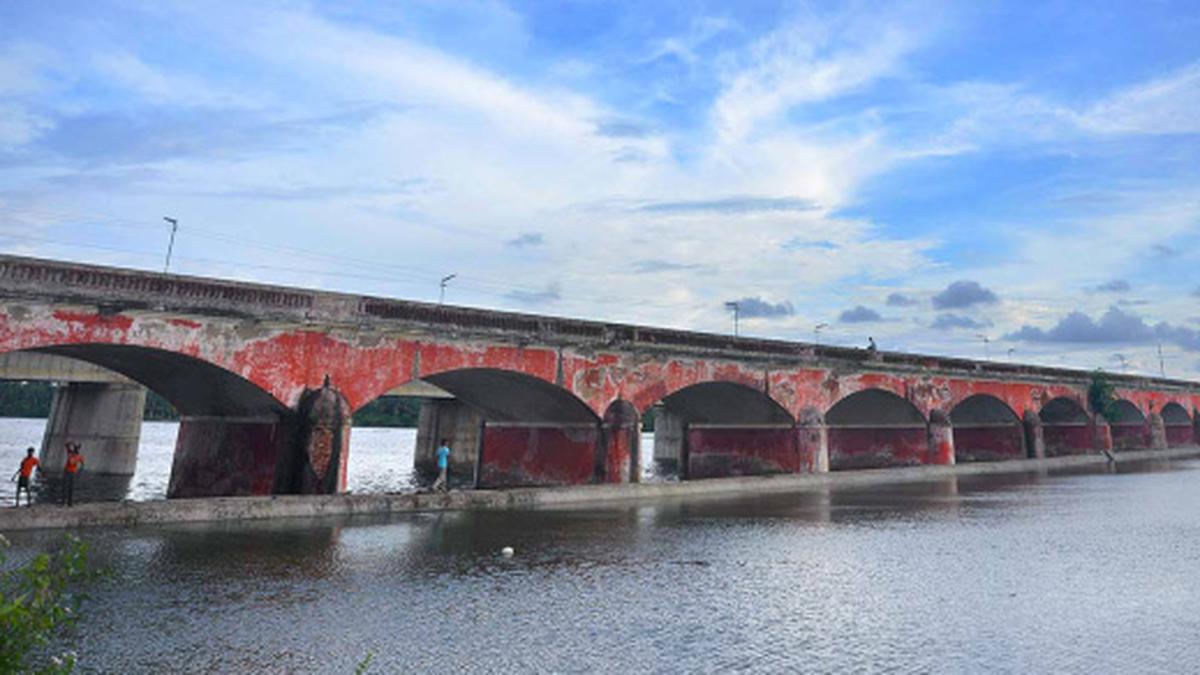- Loganatha Perumal Temple is dedicated to Vishnu located 2 km away from Sikkal, Tamil Nadu, India on the Thiruvarur-Nagapattinam highway.
- It is one of the 108 Divyadesam dedicated to Vishnu, who is worshipped as Loganatha Perumal and his consort Lakshmi as Loganayagi.
- The temple is believed to have been built by the Medieval Cholas of the late 8th century AD, with later contributions from Vijayanagar kings and Madurai Nayaks.
- The temple is also one of the Pancha Krishna Kshetram (also called Krishna Aranya Kshetram or Krishna Mangala Kshetram), which are Tirukannamangai, Tirukannapuram, Kabisthalam, Tirukovilur and Tirukannangudi.
Details of Prathyaksham:
- Brighu Maharishi is the son of Brahma. In this way he is a grandson to the Lord god.
- The same Brighu Maharishi was born as Hemarishi and gave his daughter Komalavalli to god as his wife. In this way he is father-in-law to the god.
- So, for this Brighu and his father Brahma.
- Lord Dhamodharan showed his true self.
- Uparisaravasu, was the king of Sethi Kingdom.
- He was very disciplined and lived one man – one wife's life. Due to his good conduct he got pushpaka vimana from Lord Indra and was able to fly in it in the sky.
- Throughout his life he was staunch in his one man – one wife belief.
- On the other side Gowthama Maharshi reprimanded his wife for her bad conduct.
- Thus for both these good persons Dhamodhara Perumal gave special darshan.
- To refrain us from the wrong path, the pushkarani is named after the evil demon Raavana.
- The above two things show that good and evil never goes unnoticed by the god.
PURANIC SIGNIFICANCE 1:
- Long back Vashita Maharishi made an idol of Krishna in Butter. But the butter did not melt due to his pure devotion.
- For many years he worshipped Lord Krishna made out of butter. The Lord wanted to test him and hence he transformed himself into a small boy (of Yadava caste or Idai kulam) and started eating the butter idol.
- When Vashita saw this he lost his temper and started to chase the boy, who was running towards the west side, when the boy was crossing a Magizha Maram, other rishi’s who were performing penance there caught the boy and tied him up in the tree.
- Then finally the boy showed him up. Lord Krishna was standing at the boy's place. Thus from the same place where he stood that day, he blesses us as the Lord Dhamodhara and Dhamodhara Narayanan.
- So as Lord Krishna was tied here by rishi’s this place is known as Thirukannankudi (Kudi means place of stay).
PURANIC SIGNIFICANCE 2:
- This place is related to Ramayana and Mahabaratha. In Ramayana, Lord Rama was the disciple of Vashista Maharshi but at this place Lord Krishna takes the post of the teacher and teaches “Gyana” to his student Vashista.
- In Mahabharatham, Lord Krishna was tied by Mother Yashoda for the reason of eating butter.
- For more or less the same reason he was tied here by rishi’s.
- This incident teaches an important lesson also. Though by eating his own image, the Lord Showed that Paramathma can engulf another Paramathma, it can be conquered by Jeevatma easily (ie) the Lord is in reach to man if he tries sincerely.
PURANIC SIGNIFICANCE 3:
- Thirumangai Alwar robbed a golden statue to pay for his expenses in the construction of a compound wall at Srirangam.
- When he was on his way back, he rested under a tamarind tree and requested the tree to watch over the stolen gold temporarily buried below.
- The tree is supposed to have remained on guard all night allowing Alwar to rest undisturbed. He blessed it with the name Uranga Puli (non-sleeping tamarind).
- The next morning the owner of the land arrived and claimed ownership of the gold because it was buried on his land.
- Alwar claimed he owned the land and had the proof in Srirangam. He promised to bring the proof the next day.
- He never turned up. This is considered as Theera Vazhakku (unsolved dispute).
TholaVazhaku:
- Thirumangai alwar wanted to construct a compound wall to SriRangam temple. But money shortage occurred and to avoid that he started to steal.
- Of course, when he came to Nagapatinam, he found a Golden statue of Lord Budha there and tried to steal it.
- But a wheel was rotating above the Budha idol and connections to the wheel were in the statue.
- So without stopping the wheel it was impossible to rob the idol. So, Thirumangai Mannan went across the sea to find the person who made this arrangement.
- He found him and learnt the technique to stop the wheel and returned back in a ship which contained a betel nut.
- After getting off the ship, Alwar filed a suit at the local court and won half the sacks of betel nuts contained in the ship.
- After that by inserting a banana tree bark, he stopped the wheel and stole the golden idol.
- But the monks saw him and started to chase him. He made the idol at Thirukannangudi near a bush and later took it to SriRangam.
- When the monks asked to return the idol he said that after two days he would return the idol upto the little finger and gave them just that finger alone monks filed a case and due to his clever wordings Thirumangai Alwar came out with this case too.
- As he got victory in both the cases, the cases were called “Thola Vazhakku” (ie) cases without defeat.
Oorakinaru:
- Vaanamaamalai kshetram has been Mangalasaasa named by Nammalwar. In this particular kshetram there’s a well which contains no water but oil.
- This oil has medical values and when taken cures many diseases. As devotion would cure Athma’s disease the oil of this well cures bodily included in the saying.
- As Dhamodhara Perumal guarded the golden idol of Buddha, Thirumangai Alwar was able to finish the wall and invite Nammalwar for discourse.
- So Thirukannankudi has played an indirect role in the above aspects and thus the saying is explained.
- At kannangudi, Lord Shows him off as Purijaganatha purushotama Loga naayakan and Dhamodhara Naarayanan.
- Loga Naayagan means the king of the world. So here he poses as king and as Dhamodharan Narayana he tells that even king of the world isn't powerful before pure love and devotion.
- Hence this place reminds Thirukannankudi, Thirupullani boothakudi, Ayodhya, Puri, SriRangam, Alwarthirunagari and Vanamamalai.
- “Kaya Magizh – Uragapuli – Thola Vazhaku – Oorakinaru – Thirukannankudi”. This is the old saying revolving about this place.



